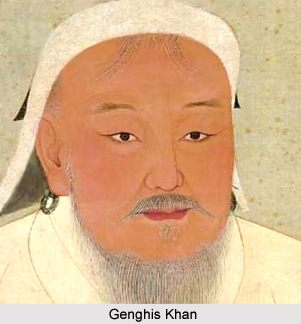 The Mongol Empire that existed during the 13th and 14th centuries dominated over the Eastern Europe, parts of Siberia, Middle East, Southeast Asia, the Iranian plateau and the Indian subcontinent. The Mongol Empire that functioned under the rule of Genghis Khan invaded the Indian subcontinent from 1221 to 1327. The Mongols waged several wars. However, they remained unsuccessful against the Delhi Sultanate.
The Mongol Empire that existed during the 13th and 14th centuries dominated over the Eastern Europe, parts of Siberia, Middle East, Southeast Asia, the Iranian plateau and the Indian subcontinent. The Mongol Empire that functioned under the rule of Genghis Khan invaded the Indian subcontinent from 1221 to 1327. The Mongols waged several wars. However, they remained unsuccessful against the Delhi Sultanate.
Genghis Khan chased Jalal ad-Din, the prince of Delhi, from Samarkand into India and later defeated him in the Battle of Indus in 1221. The commander appointed two of his competent commanders Bala and Dorbei the Fierce as the head of 20,000 soldiers and sent them behind Jalal ad-Din to pursue the chase. Throughout the Punjab region Bala chased Jalal ad-Din, invading remote towns and cities such as Bhera and Multan on his way. The Mongol commander even ransacked the fringes of Lahore.
With the surviving forces Jalal ad-Din formed a new army and sought for a pact or even refuge with the Turkic rulers of Delhi Sultanate. His request was however, denied. Jalal ad-Din waged war against the local rulers residing in Punjab. With his strong army he easily defeated them but failed to attain their lands. The Delhi prince finally proposed for a treaty with the khokhar chieftain of the Salt Range. He also married the chieftain`s daughter. As soon as the alliance was formed, Khokhar Rai`s son along with his clansmen joined hands with the army of Jalal ad-Din. He was bestowed upon the title of Kalich (sword) Khan. The army of Jalal ad-Din fought under the officers Uzbek Pai and Hassan Qarlugh.
During the invasion on India the Khokhar tribe of Punjab was associated with the Mongols. Jalal ad-Din, while engaged in a war with the local governor of Sindh, received the news of military unrest in the Kirman province of southern Iran. He with his forces soon marched towards the location. He passed over Baluchistan while travelling with his forces to the place. Army forces from Ghor and Peshawar also joined hands with Jalal ad-Din. This also included the forces of Turkoman, Khilji and Ghori tribes. With the new forces formed, Jalal ad-Din travelled towards Ghazni and overpowered a Mongol army under Turtai. The Mongol had been relegated the duty of hunting and capturing Jalal ad-Din. Soon a quarrel broke out among the victorious army over the captured wealth. Consequently the Turkoman, Khilji and Ghori tribesmen abandoned Jalal ad-Din and went back to Peshawar. At this time the third son of Genghis Khan, Ogedei Khan, had assumed the title of Great Khan of the Mongol Empire. He sent a huge force under general named Chormaqan who defeated Jalal ad-Din and thus, ended the reign of Khwarazm Shah Dynasty.



















